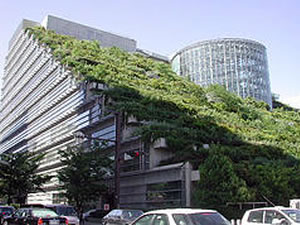
Cutting energy consumption stands as a lucrative opportunity for the commercial real estate market, according to a report just announced by KPMG LLC. It is possible to reduce energy use by 30-50 percent in commercial buildings, providing a positive return on investments, KPMG found.
KMPG released its report, Climate Change: Risks & Opportunities in the Canadian Commercial Real Estate Market, just days ahead of TowardsNET-ZERO, a global forum for cutting carbon emissions in buildings to be held in London on Friday, Nov. 20. The conference is coming to Washington, D.C., and San Francisco in 2010.
Phil Ludvigsen, Director of Carbon Advisory Services at KPMG attested to the benefits of looking to energy for cost cutting, including easier facility zoning and permitting, reduced tax burdens, and potentially lower insurance premiums. Reducing power demand also lessens direct and indirect greenhouse gas emissions generated by commercial buildings, he said. Pollution is created from the on-site combustion of fuels for heating and cooling, the use of refrigerants, which are powerful greenhouse gasses, and fuel combustion related to producing construction materials and electricity used in the buildings.
"Going green is not just good for the environment, but can also make solid business sense," Ludvigsen said.
Ludvigsen opined that commercial property will increasingly be bought and sold within a low-carbon economy. Large commercial real estate holdings should have a carbon management strategy in place to assess a carbon footprint, he said. Reducing and managing energy consumption will help to attract the best deals and investors and retain key tenants.
The U.S. EPA’s ENERGY STAR Building Upgrade Manual recommends upgrading buildings in steps, beginning with lighting and supplemental loads. Following lighting and equipment and appliance power changes, assessments should continue with the building envelope, then controls, then heat exchange equipment, and finally heating and cooling systems. According to ENERGY STAR, lighting and other appliances generate a significant amount of heat. The downstream savings of lighting efficiency measures can therefore include cost savings in facility HVAC operation and energy use.
Small and large businesses and universities are taking advantage of the savings and return on investment building retrofits have to offer. For example, large companies such as Dole, Walmart, Holiday Inn, New York Times, Arby’s, and SunGard have reduced costs by installing energy efficient lighting in their buildings. A family-owned Pennsylvania pet store expects to save $200,000 in electricity costs as a result of a lighting upgrade. One private company, LED Saving Solutionsis in the business of making energy efficiency possible and has forged production and financial partnerships that allow it to take on the initial cost of replacing conventional lighting, making the retrofit cash-flow positive for properties from the start.

